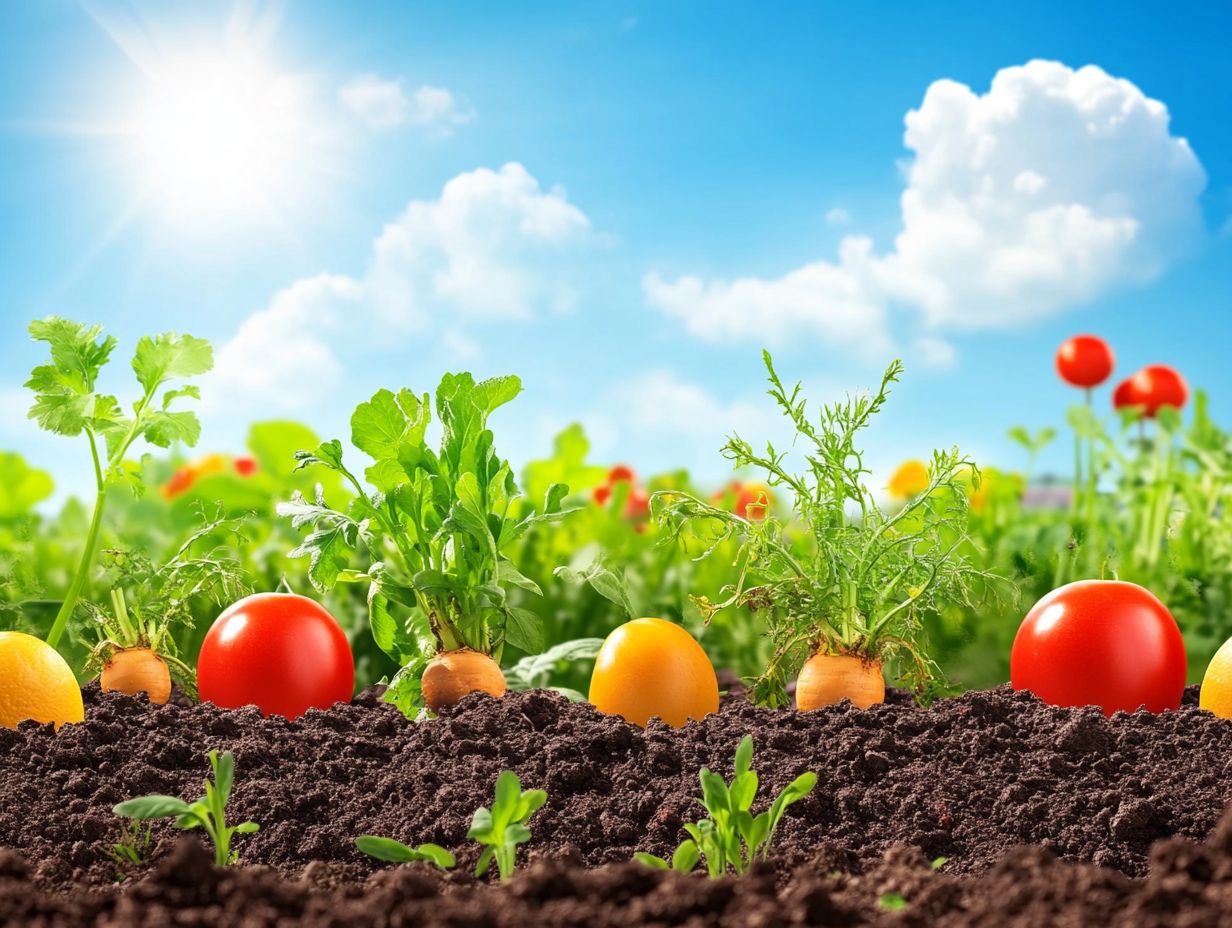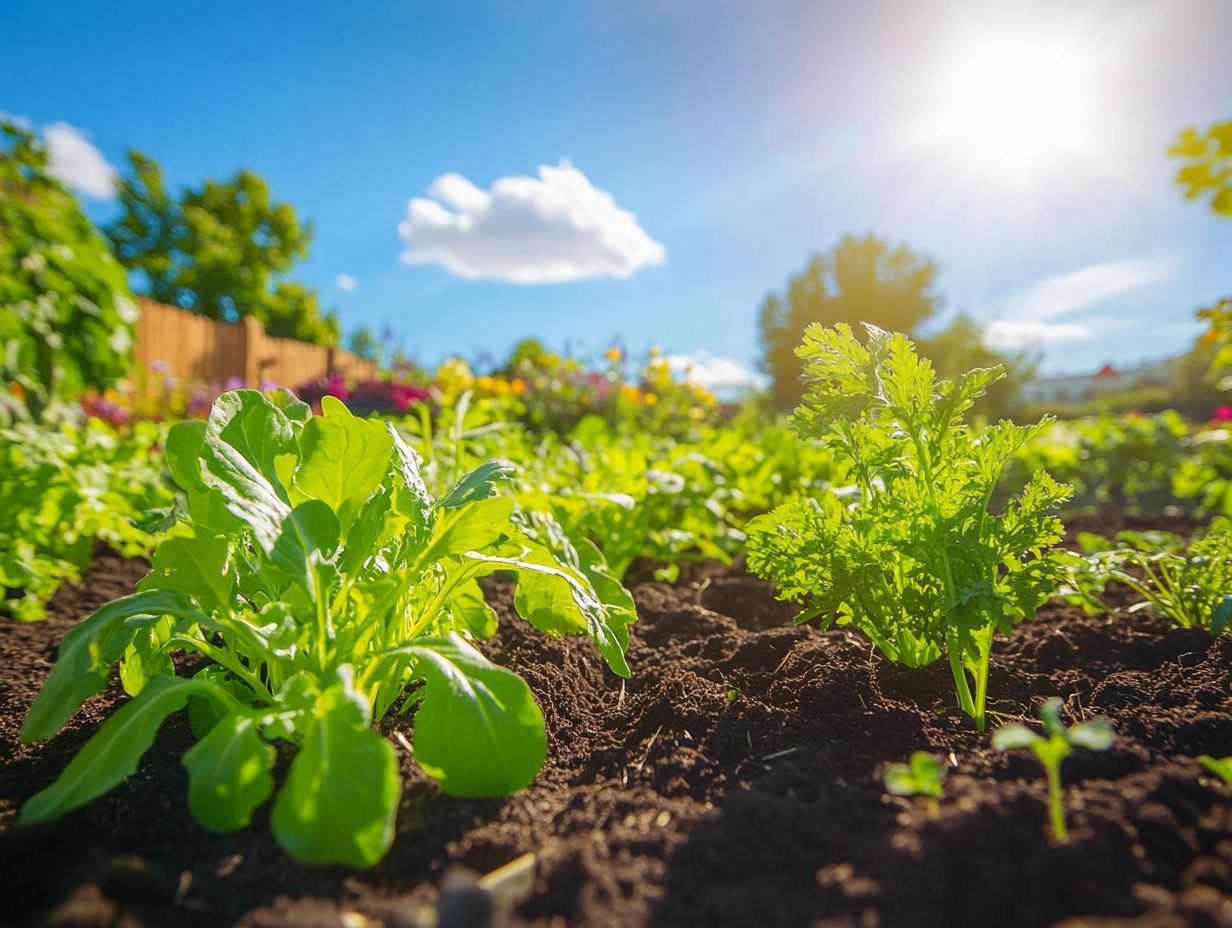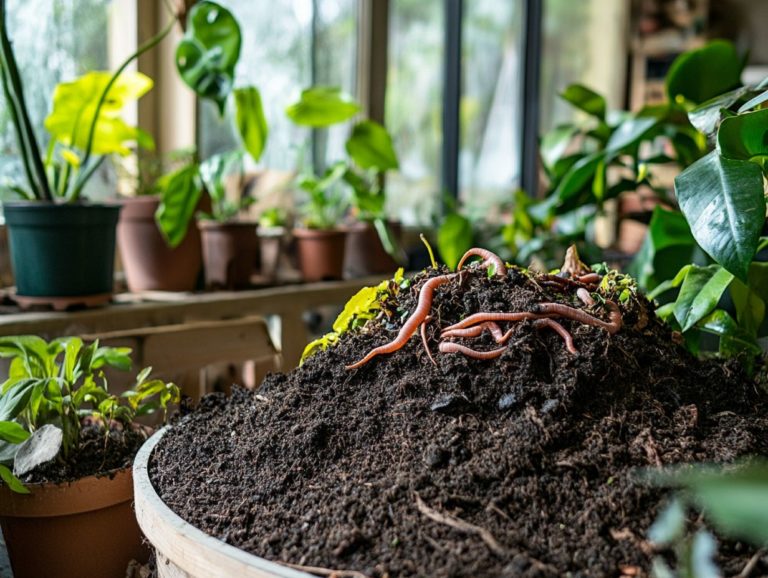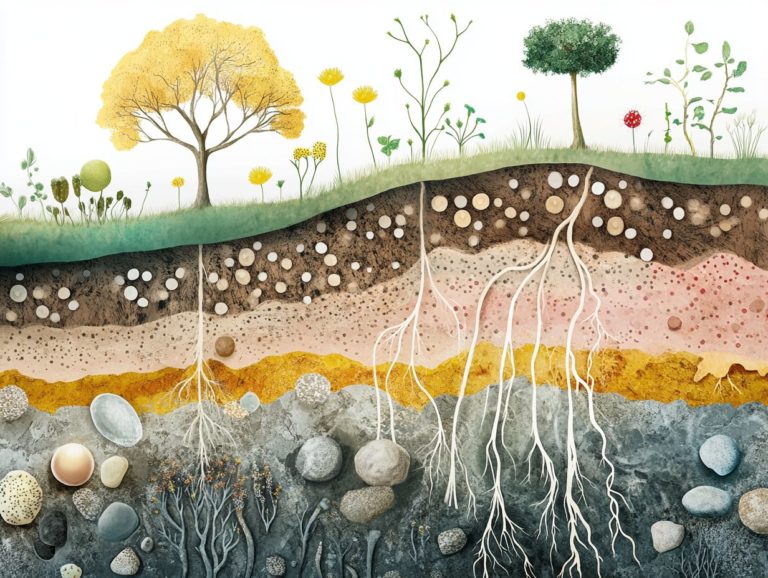Understanding Soil Fertility and Plant Growth
Soil fertility stands as a cornerstone of successful agriculture and sustainable land management. It embodies the soil’s capacity to supply essential nutrients, water, and optimal conditions for robust plant growth. Unlock the secrets to thriving plants now!
Let s dive into what soil fertility genuinely entails, the myriad factors influencing it, including soil structure and microbial activity, and its pivotal role in fostering healthy plants while maximizing yields. You ll discover effective techniques for enhancing soil fertility, methods for measuring it, and a debunking of prevalent misconceptions that might obstruct your gardening or farming endeavors. Immerse yourself in this journey to unveil the secrets of nurturing your soil for flourishing plants!
Contents
Key Takeaways:

- Soil fertility is the ability of soil to support plant growth and sustain healthy plants.
- Physical, chemical, and biological factors all play a role in maintaining soil fertility.
- Regular testing, proper fertilization techniques, and soil amendments are crucial for maintaining and improving soil fertility for optimal plant growth and yield.
What is Soil Fertility?
Soil fertility is an essential concept in agriculture, representing the soil’s capacity to deliver vital plant nutrients to crops, which is key to robust growth and impressive crop yields. It involves a multitude of factors, such as soil organic matter, nutrient availability, and the overall well-being of the soil ecosystem. This includes crucial elements like microbial activity, earthworm populations, and diverse soil organisms contributing to nutrient cycling.
Grasping and managing soil fertility is imperative for sustainable agricultural practices. This enables you to maintain a nutrient balance that fosters plant health, ensures nutrient release, and maximizes productivity.
Defining Soil Fertility and its Importance
Defining soil fertility means understanding the intricate balance of nutrients and the overall health of your soil, which directly influences the growth and vitality of your plants.
Several factors contribute to this delicate equilibrium, including the availability of essential nutrients like nitrogen, phosphorus, and potassium, along with the quality of organic matter present in the soil. These elements are pivotal for various physiological processes that foster strong root development, vibrant flowering, and fruitful yields. Aspects such as soil pH and texture also significantly affect nutrient availability, soil compaction, and microbial activity.
Regular soil testing is crucial for monitoring these fertility levels. This allows you to make informed adjustments and effectively utilize organic fertilizers. By nurturing a healthy soil ecosystem through practices like crop rotation, you can ensure sustainable plant growth and impressive productivity in your garden or farm. Understanding soil structure for plant growth can further enhance your gardening success.
Factors Affecting Soil Fertility
Soil fertility is shaped by a complex interplay of factors that can be classified into physical, chemical, and biological aspects. This includes the soil s ability to hold onto nutrients, which influences nutrient retention. Each of these elements plays a vital role in determining the soil’s ability to sustain plant life, improve water-holding capacity, and enhance agricultural productivity.
Understanding this intricate balance is essential for anyone looking to cultivate thriving crops.
Physical, Chemical, and Biological Factors
The physical, chemical, and biological factors influencing soil fertility are quite intricate. They comprise aspects such as soil structure, pH levels, and the presence of essential soil organisms like microbes and earthworms.
Understanding these elements is paramount if you aim to optimize crop yields and champion sustainable agriculture through effective fertilizer management.
Consider soil texture, which refers to the proportions of sand, silt, and clay. It plays a crucial role in determining water retention and aeration, thereby impacting nutrient uptake and overall soil health.
The pH level of the soil also holds significant importance. It affects the availability of essential nutrients and microbial activity that aids in mineralization. For instance, slightly acidic conditions often enhance nutrient accessibility for many crops.
The cation exchange capacity (CEC) measures how well the soil retains important nutrients like calcium, potassium, and magnesium elements critical for plant growth and supporting the earthworm population that enriches soil structure.
Microbial activity includes beneficial organisms like bacteria and fungi that enrich nutrient cycling and soil structure. This ultimately cultivates a healthier ecosystem, ensuring your plants receive the nutrients they need for optimal growth.
The Relationship Between Soil Fertility and Plant Growth

The connection between soil fertility and plant growth is complex. The availability of essential nutrients within the soil plays a pivotal role in shaping the health, yield, and overall productivity of your crops, including the availability of organic fertilizers.
Grasping this relationship is crucial for cultivating a thriving garden or farm that maximizes both plant health and soil vitality.
How Soil Fertility Impacts Plant Health and Yield
Soil fertility plays a crucial role in your plants’ health and yield. It determines the availability of essential nutrients, such as those derived from compost, which can either foster growth or lead to nutrient shortages that can be frustrating.
When your soil is rich in organic matter and minerals, your plants thrive, showcasing vibrant foliage and yielding plentiful fruit. On the flip side, if essential nutrients are lacking whether due to inadequate soil management or environmental factors the repercussions can be quite serious. Nutrient deficiencies may show up as stunted growth, yellowing leaves, and disappointing crop yields.
To uphold optimal soil fertility, consider using soil amendments like compost tea and green manure to enrich nutrient levels and boost microbial activity.
Effective fertilizer management is key; it ensures your plants receive precisely what they need throughout their growing cycles, significantly enhancing overall productivity.
Methods for Improving Soil Fertility
Enhancing soil fertility requires a multifaceted approach. This approach elevates nutrient availability, improves soil structure, and increases moisture retention. By adopting these methods, you promote healthier plant growth and contribute to sustainable agricultural practices.
Fertilization Techniques and Soil Amendments
Fertilization techniques and soil amendments are vital in enhancing soil fertility. They help improve nutrient retention and availability for your plants.
You can choose from various methods, including:
- Organic fertilizers like compost and well-rotted manure
- Inorganic options such as synthetic fertilizers, which provide immediate nutrient access
By integrating these practices, you can significantly elevate your soil’s nutrient profile. Soil amendments, such as biochar and green manure, boost soil organic matter, creating a vibrant ecosystem that retains moisture and enhances fertility naturally.
This, in turn, promotes healthier plant growth. Understanding the proper application and balance of these techniques can lead you to sustainable agricultural practices that nourish your crops and protect the environment.
Start improving your soil today for a flourishing garden tomorrow!
Measuring and Maintaining Soil Fertility
Measuring and maintaining soil fertility is essential for ensuring long-term agricultural productivity. This process requires you to conduct regular assessments of soil health through comprehensive soil testing, including soil tests for pH and nutrient retention.
By prioritizing these evaluations, you can safeguard the vitality of your land and optimize its performance for years to come, ultimately supporting sustainable agricultural practices.
Testing and Monitoring Soil Health

Actively test and monitor your soil! This is crucial for healthy plant growth. To test soil health, evaluate key factors. These include soil pH, microbial activity, and nutrient retention.
Use methods like laboratory analysis and field sampling to pinpoint the balance of essential nutrients nitrogen, phosphorus, and potassium that are crucial for robust plant growth. Regular testing is invaluable. It helps you identify any deficiencies or imbalances in nutrient levels, enabling you to implement tailored amendments based on soil characteristics that can significantly enhance soil composition.
Gaining insight into organic matter content and soil texture will improve water retention and aeration, benefiting plant growth and making it easier for roots to access the nutrients they need.
This proactive approach not only sustains soil fertility but also fosters effective nutrient recycling, ensuring long-term agricultural productivity and enhancing the overall health of the ecosystem.
Common Misconceptions About Soil Fertility
Common misconceptions about soil fertility can lead to improper management practices, ultimately impacting nutrient availability, mineralization, and the overall vitality of the soil ecosystem. Understanding the nuances of soil health is crucial for nurturing a robust agricultural environment and promoting effective composting techniques.
Debunking Myths and Misunderstandings
Debunking myths and misunderstandings about soil fertility unveils the intricate nature of nutrient management and underscores the significance of proper fertilization practices.
Many believe that pouring on more fertilizer is always a good idea, but this misconception can lead to nutrient imbalances, detrimental effects on soil biology, and even environmental damage. Others might think that organic methods lack the punch of synthetic fertilizers. However, research demonstrates that a well-balanced organic approach, including the use of organic fertilizers, can profoundly improve soil health over time.
The notion that soil is a static entity requiring no regular analysis is simply incorrect. Soil health is dynamic, influenced by factors like crop rotation, organic fertilizers, climate conditions, and soil pH. By tackling these myths, you can foster healthier, more productive soils.
Frequently Asked Questions
What is Soil Fertility?
Soil fertility is the ability of soil to provide essential nutrients for plant growth. It depends on factors like organic matter, moisture retention, and soil structure. Proper management of these elements is vital for healthy crops and supports effective agricultural practices.
How does Soil Fertility Affect Plant Growth?

Soil fertility directly affects plant growth. It provides essential nutrients, water, and air. Without proper soil fertility, plants face challenges due to soil compaction, mineralization, and the roles of earthworms and microorganisms. Compost, green manure, and soil amendments can enhance water-holding capacity and nutrient retention, including nitrogen, phosphorus, and potassium. If these nutrients are not available, plants may suffer from deficiencies and struggle to thrive.
What Factors Influence Soil Fertility?
The three main factors that influence soil fertility are climate, topography, and parent material. Climate affects the rate of soil formation. Topography determines the physical characteristics of the soil. Parent material contributes to the type and amount of nutrients present in the soil.
What Are the Signs of Poor Soil Fertility?
Poor soil fertility can manifest in various ways. Signs include stunted growth, yellowing leaves, and decreased yield. These symptoms often result from nutrient deficiencies. Soil testing can help identify specific deficiencies and guide proper fertilization.
How Can I Improve Soil Fertility?
You can improve soil fertility by adding organic matter, using cover crops, practicing crop rotation, or applying fertilizers. Cover crops are plants grown primarily to improve soil health. Crop rotation involves alternating different crops over time to maintain soil nutrients. Consider the specific needs of your plants and soil for the best results.
What Is the Role of Soil Fertility in Sustainable Agriculture?
Soil fertility is crucial for sustainable agriculture. It promotes healthy and productive soil while reducing the need for chemical fertilizers. Sustainable farming practices aim to maintain and improve soil fertility for the benefit of current and future generations.






